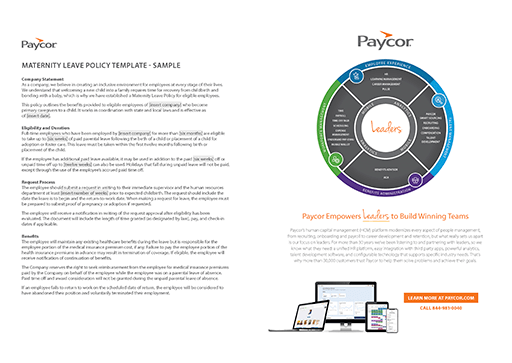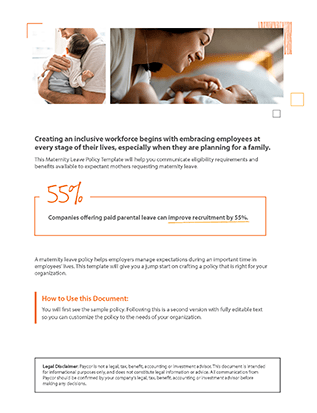One Minute Takeaway
- Creating an inclusive workforce begins with embracing employees at every stage of their lives
- A maternity leave policy helps new parents ease into the transition of having a family
- Paid leave policies are not required by law, but are great opportunities for employers
Get Our Maternity Leave Template
Celebrating the addition of a baby is an important time in a person’s life. As an HR leader you play an important role in reducing stress for the new parent by helping them prepare for their time away from work.
Currently, there is no overarching federal legislation requiring employers to offer paid maternity leave. The Family and Medical Leave Act (FMLA) requires employers to grant 12 weeks of unpaid leave to eligible employees, but the rules only apply to organizations with more than 50 employees. In 2020, federal government employees were granted up to 12 weeks of paid maternity leave through FMLA, but only 20% of private sector workers have the same benefit.
25% of employees in 2022 had some sort of paid leave in March last year versus 19% in 2019 (DOL). 7 states plus the District of Columbia require employers to provide paid leave, up from just 4 in 2018. 4 more states will require paid parental leave by 2026. You can find updated maternity leave laws by state here.
What is a Maternity Leave Policy?
A maternity leave policy is a critical part of an organization’s benefits package that gives parents who have just given birth or adopted a child guidance on how much time they’re permitted to take to adjust to life after the child arrives. Some organizations have parental leave policies, paternity leave policies, and/or adoption leave policies to accommodate all families’ needs. An established policy should include details on who is eligible for paid maternity leave, how much time can be granted based on laws, and how to make requests.
What is a maternity leave plan?
A maternity leave plan helps your employee and team prepare for a parent’s temporary leave of absence. It outlines what will be completed prior to leave and who is responsible for day-to-day tasks in the interim.
This Is an Example of a Maternity Leave Plan
| Current Responsibilities | Task Due Date | Assigned Back-Up | Briefing date | Stakeholder/Client/Approver Name & Contact Information | Status (update weekly) |
|---|---|---|---|---|---|
| New Product Project Management | 6/24 | Jodie Hall | 6/1 | Whitney Robinson | Packaging design approved. Marketing plan complete. |
Why Is Offering Maternity Leave Important?
Certainly, a generous, well-crafted maternity leave policy can help ease the transition back to work for new parents but there are also additional benefits to employers who create a parental leave policy. If you haven’t already established a policy, here are a few reasons why you should consider it.
- Create an equitable environment – Offering maternity leave is important to women’s equity because, if not granted, it drives women who choose to become mothers out of the workforce. It also widens the gender wage gap.
- Business continuity – A set policy helps managers manage expectations for how many weeks an employee will be away and plan how work will be re-allocated and resume when the team member returns.
- Recruitment and retention tool –SHRM found that a company’s practice of offering paid parental leave improved recruitment by 55% and retention by 58%. This benefit enforces a culture where work and personal lives are balanced and provides clarity to employees who are planning families.
What’s included in a Maternity Leave Policy?
A maternity leave policy generally includes the following:
- Your organization’s statement: This statement includes rationale for why your organization believes a maternity policy is important. It can be general or incorporate company core values.
- Eligibility definition: This statement outlines who is eligible to receive paid maternity leave based on their employment status (full-time or part-time).
- Duration: An explanation of how the time for paid leaveis calculated.
- Legal information: An explanation of how the policy coordinates with federal (see Understanding FMLA), state, and local laws and other organizational policies.
- Requests: A maternity leave policy will also outline the process for making a request.
Getting started on your own maternity leave policy is easy with our free customizable template. Fill out the form at the top of the page to download it now to begin.











